Sunday, October 3, 2021 - Africa
- Mary Reed

- Oct 3, 2021
- 22 min read
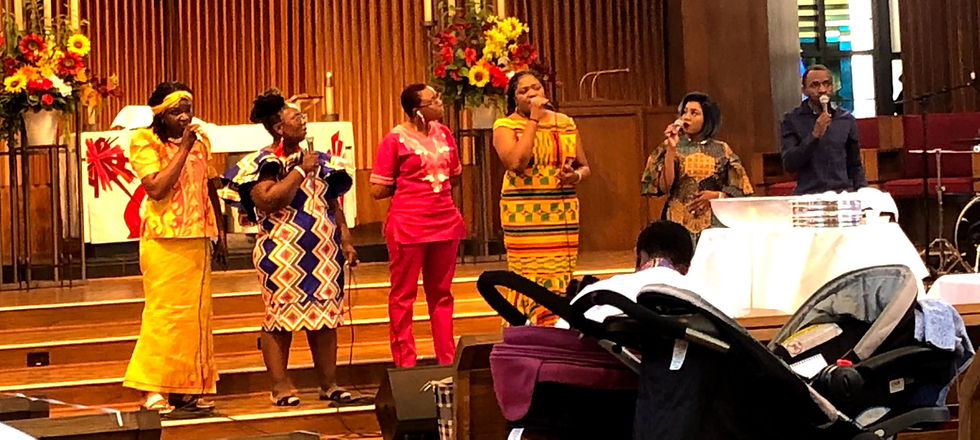
The photo is of the African Praise Team at my church, Lovers Lane United Methodist Church. Today the African Fellowship at LLUMC led some of the traditional service. Their songs like “Minana” or “You Perform Miracles,” “Hakuna wakaita sa Jesu” or “There is No One Like Jesus” and “Mungu Ibariki Afrika” or “God Bless Africa” are sung in an African language and are full of joy. Many of the African members have been at LLUMC for as many as 35 years. The women often wear colorful headdresses and clothes made of kente cloth, a Ghanian textile made of handwoven strips of silk and cotton. They are delightful people and so much fun to be around, often dancing when they sing. According to nature.com, researchers led by Ulf Gyllensten of the University of Uppsala in Sweden have found evidence that we are all descended from a single ancestral group that lived in Africa about 170,000 years ago. And they suggest that modern humans spread across the globe from Africa in an exodus that took place only around 50,000 years ago. So, we are all Africans originally. Let’s learn more about Africa.
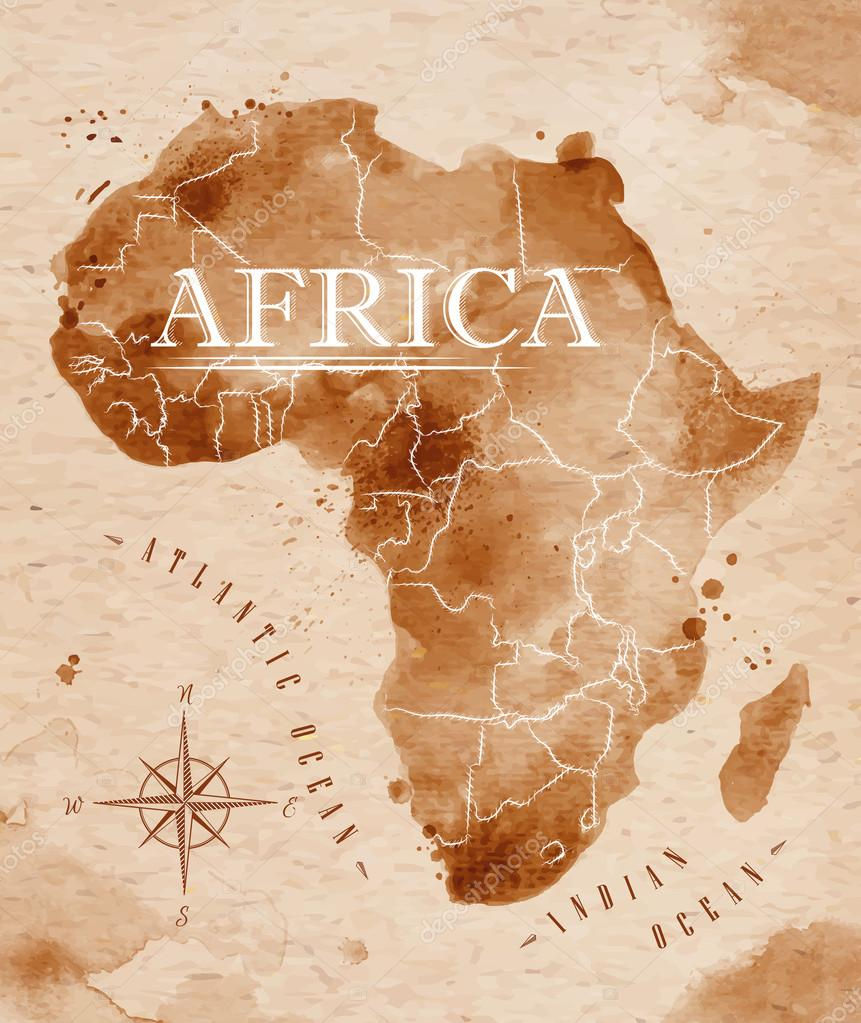
According to Wikipedia, Africa is the world's second largest and second most populous continent, after Asia in both cases. At about 11.7 million square miles including adjacent islands, it covers 6% of Earth's total surface area and 20% of its land area. With 1.3 billion people as of 2018, it accounts for about 16% of the world's human population. Africa's population is the youngest among all the continents; the median age in 2012 was 19.7, when the worldwide median age was 30.4. Despite a wide range of natural resources, Africa is the least wealthy continent per capita, in part due to geographic impediments, legacies of European colonization in Africa and the Cold War, predatory/neo-colonialistic activities by Western nations and China and undemocratic rule and deleterious policies. Despite this low concentration of wealth, recent economic expansion and the large and young population make Africa an important economic market in the broader global context.
The continent is surrounded by the Mediterranean Sea to the north, the Isthmus of Suez and the Red Sea to the northeast, the Indian Ocean to the southeast and the Atlantic Ocean to the west. The continent includes Madagascar and various archipelagos. It contains 54 fully recognized sovereign states, eight territories and two de facto independent states with limited or no recognition. Algeria is Africa's largest country by area, and Nigeria is its largest by population. African nations cooperate through the establishment of the African Union, which is headquartered in Addis Ababa, Ethiopia.

Africa straddles the equator and the prime meridian, making it the only continent in the world to be situated in all four cardinal hemispheres. It is the only continent to stretch from the northern temperate to southern temperate zones. The majority of the continent and its countries are in the Northern Hemisphere, with a substantial portion and number of countries in the Southern Hemisphere. Most of the continent lies in the tropics, except for a large part of Western Sahara, Algeria, Libya and Egypt; the northern tip of Mauritania; and the entire territories of Morocco, Ceuta, Melilla and Tunisia which are located above the tropic of Cancer in the northern temperate zone. In the other extreme of the continent, southern Namibia, southern Botswana, great parts of South Africa, the entire territories of Lesotho and Eswatini and the southern tips of Mozambique and Madagascar are located below the tropic of Capricorn in the southern temperate zone.
Africa is home to much biodiversity; it is the continent with the largest number of megafauna species, as it was least affected by the extinction of the Pleistocene megafauna. However, Africa also is heavily affected by a wide range of environmental issues, including desertification, deforestation, water scarcity and other issues. These entrenched environmental concerns are expected to worsen as climate change impacts Africa. The UN Intergovernmental Panel on Climate Change has identified Africa as the continent most vulnerable to climate change.
The history of Africa is long, complex and has often been underappreciated by the global historical community. Africa — particularly Eastern Africa — is widely accepted as the place of origin of humans and the Hominidae clade or great apes. The earliest hominids and their ancestors have been dated to around 7 million years ago, including Sahelanthropus tchadensis, Australopithecus africanus, A. afarensis, Homo erectus, H. habilis and H. ergaster — the earliest Homo sapiens or modern human remains found in Ethiopia, South Africa and Morocco circa 200,000, 259,000 and 300,000 years ago respectively. Homo sapiens is believed to have originated in Africa around 350,000–260,000 years ago.
Early human civilizations, such as Ancient Egypt and Carthage emerged in North Africa. Following a subsequent long and complex history of civilizations, migration and trade, Africa hosts a large diversity of ethnicities, cultures and languages. The last 400 years have witnessed an increasing European influence on the continent. Starting in the 16th century, this influence was driven by trade — including the Trans-Atlantic slave trade, which created large African diaspora populations in the Americas. In the late 19th century, European countries colonized almost all of Africa, extracting resources from the continent and exploiting local communities; most present states in Africa emerged from a process of decolonization in the 20th century.
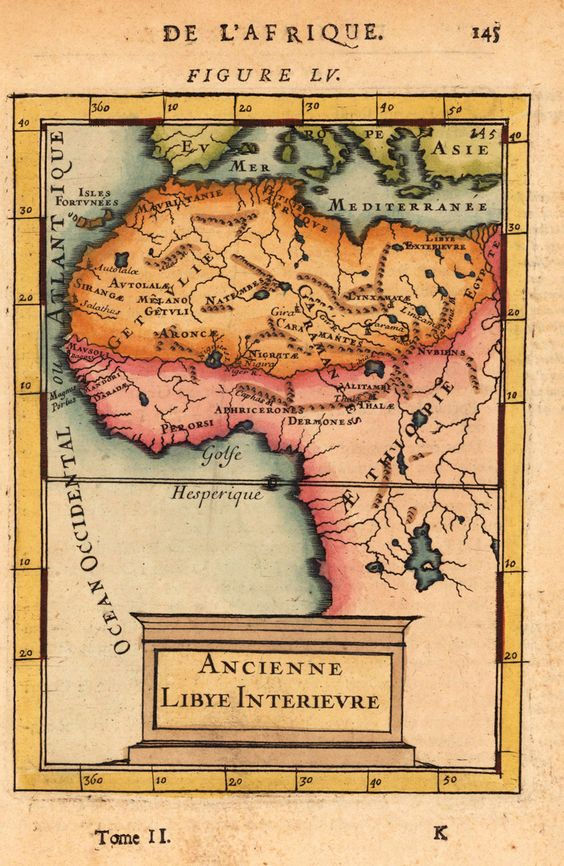
Etymology
Afri was a Latin name used to refer to the inhabitants of then-known northern Africa to the west of the Nile river, and in its widest sense referred to all lands south of the Mediterranean or Ancient Libya. This name seems to have originally referred to a native Libyan tribe, an ancestor of modern Berbers. The name had usually been connected with the Phoenician word “afar” meaning "dust," but a 1981 hypothesis has asserted that it stems from the Berber word ifri meaning "cave," in reference to cave dwellers. The same word may be found in the name of the Banu Ifran from Algeria and Tripolitania, a Berber tribe originally from Yafran — also known as Ifrane — in northwestern Libya, as well as the city of Ifrane in Morocco.
Under Roman rule, Carthage became the capital of the province it then named Africa Proconsularis, following its defeat of the Carthaginians in the Third Punic War in 146 BC, which also included the coastal part of modern Libya. The Latin suffix -ica can sometimes be used to denote a land e.g., in Celtica from Celtae, as used by Julius Caesar. The later Muslim region of Ifriqiya — following its conquest of the Byzantine or Eastern Roman Empire's Exarchatus Africae — also preserved a form of the name.
According to the Romans, Africa lies to the west of Egypt, while "Asia" was used to refer to Anatolia and lands to the east. A definite line was drawn between the two continents by the geographer Ptolemy (85–165 AD), indicating Alexandria along the Prime Meridian and making the isthmus of Suez and the Red Sea the boundary between Asia and Africa. As Europeans came to understand the real extent of the continent, the idea of "Africa" expanded with their knowledge.
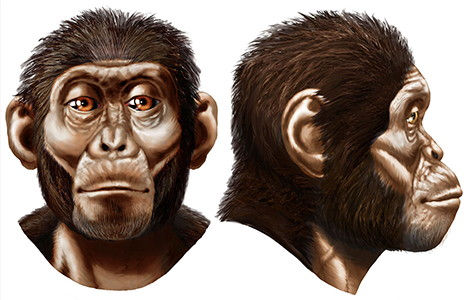
Prehistory
Africa is considered by most paleoanthropologists to be the oldest inhabited territory on Earth, with the human species originating from the continent. During the mid-20th century, anthropologists discovered many fossils and evidence of human occupation perhaps as early as 7 million years ago. Fossil remains of several species of early apelike humans thought to have evolved into modern man — such as Australopithecus afarensis radiometrically dated to approximately 3.9–3.0 million years Before Present or BP, Paranthropus boisei (c. 2.3–1.4 million years BP) and Homo ergaster (c. 1.9 million–600,000 years BP) — have been discovered.
After the evolution of Homo sapiens approximately 350,000 to 260,000 years BP in Africa, the continent was mainly populated by groups of hunter-gatherers. These first modern humans left Africa and populated the rest of the globe during the Out of Africa II migration dated to approximately 50,000 years BP, exiting the continent either across Bab-el-Mandeb over the Red Sea, the Strait of Gibraltar in Morocco or the Isthmus of Suez in Egypt.
Other migrations of modern humans within the African continent have been dated to that time, with evidence of early human settlement found in Southern Africa, Southeast Africa, North Africa and the Sahara.

Emergence of civilization
The size of the Sahara has historically been extremely variable, with its area rapidly fluctuating and at times disappearing depending on global climatic conditions. At the end of the Ice ages, estimated to have been around 10,500 BC, the Sahara had again become a green fertile valley, and its African populations returned from the interior and coastal highlands in Sub-Saharan Africa, with rock art paintings depicting a fertile Sahara and large populations discovered in Tassili n'Ajjer dating back perhaps 10 millennia. However, the warming and drying climate meant that by 5000 BC, the Sahara region was becoming increasingly dry and hostile. Around 3500 BC, due to a tilt in the earth's orbit, the Sahara experienced a period of rapid desertification. The population trekked out of the Sahara region towards the Nile Valley below the Second Cataract — shallow length of the Nile River — where they made permanent or semi-permanent settlements. A major climatic recession occurred, lessening the heavy and persistent rains in Central and Eastern Africa. Since this time, dry conditions have prevailed in Eastern Africa and — increasingly during the last 200 years — in Ethiopia.
The domestication of cattle in Africa preceded agriculture and seems to have existed alongside hunter-gatherer cultures. It is speculated that by 6000 BC, cattle were domesticated in North Africa. In the Sahara-Nile complex, people domesticated many animals, including the donkey and a small screw-horned goat which was common from Algeria to Nubia.
Between 10,000–9,000 BC, pottery was independently invented in the region of Mali in the savannah of West Africa.
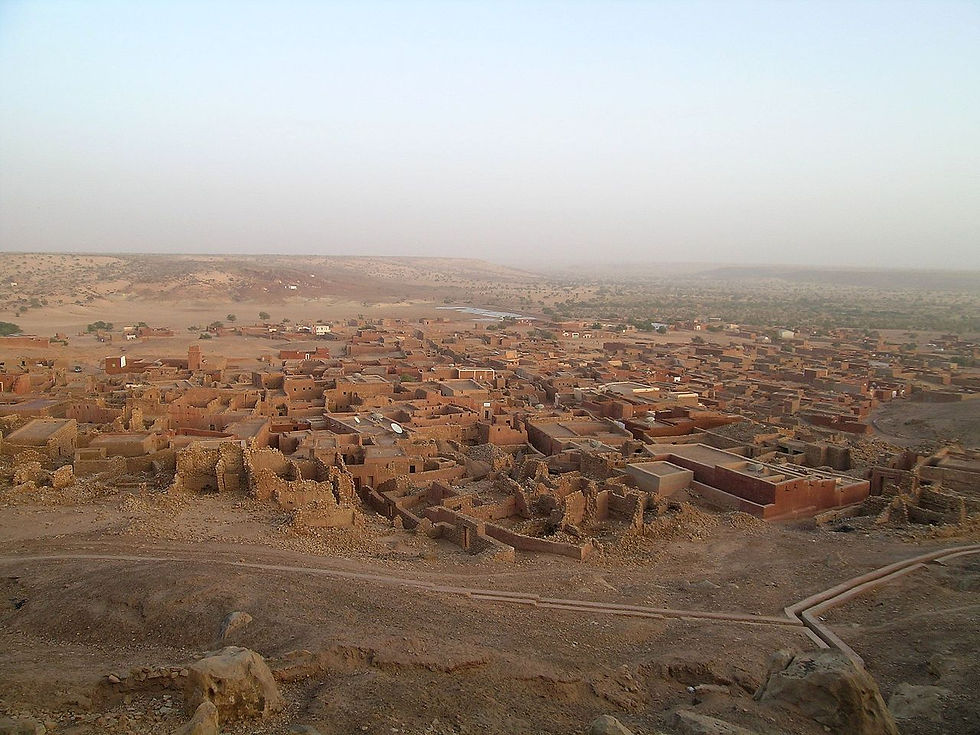
In the steppes and savannahs of the Sahara and Sahel in Northern West Africa, the Nilo-Saharan speakers and Mandé peoples started to collect and domesticate wild millet, African rice and sorghum between 8,000 and 6,000 BC. Later, gourds, watermelons, castor beans and cotton were also collected and domesticated. They also started making pottery and built stone settlements e.g., Tichitt and Oualata. Fishing using bone-tipped harpoons became a major activity in the numerous streams and lakes formed from the increased rains. Mande peoples have been credited with the independent development of agriculture by about 3,000–4,000 BC. In West Africa, the wet phase ushered in an expanding rainforest and wooded savanna from Senegal to Cameroon.
Between 9,000 and 5,000 BC, Niger–Congo speakers domesticated the oil palm and raffia palm. Black-eyed peas and voandzeia or African groundnuts were domesticated, followed by okra and kola nuts. Since most of the plants grew in the forest, the Niger–Congo speakers invented polished stone axes for clearing forest.
Around 4000 BC, the Saharan climate started to become drier at an exceedingly fast pace. This climate change caused lakes and rivers to shrink significantly and caused increasing desertification. This, in turn, decreased the amount of land conducive to settlements and helped to cause migrations of farming communities to the more tropical climate of West Africa.
By the first millennium BC, ironworking had been introduced in Northern Africa. Around that time it also became established in parts of sub-Saharan Africa, either through independent invention there or diffusion from the north and vanished under unknown circumstances around 500 AD, having lasted approximately 2,000 years, and by 500 BC, metalworking began to become commonplace in West Africa. Ironworking was fully established by roughly 500 BC in many areas of East and West Africa, although other regions didn't begin ironworking until the early centuries AD. Copper objects from Egypt, North Africa, Nubia and Ethiopia dating from around 500 BC have been excavated in West Africa, suggesting that trans-Saharan trade networks had been established by this date.

Early civilizations
At about 3300 BC, the historical record opens in Northern Africa with the rise of literacy in the Pharaonic civilization of Ancient Egypt. One of the world's earliest and longest-lasting civilizations, the Egyptian state continued — with varying levels of influence over other areas — until 343 BC. Egyptian influence reached deep into modern-day Libya and Nubia, and, according to Martin Bernal, as far north as Crete.
An independent center of civilization with trading links to Phoenicia was established by Phoenicians from Tyre on the north-west African coast at Carthage.
European exploration of Africa began with Ancient Greeks and Romans. In 332 BC, Alexander the Great was welcomed as a liberator in Persian-occupied Egypt. He founded Alexandria in Egypt, which would become the prosperous capital of the Ptolemaic dynasty after his death.

Following the conquest of North Africa's Mediterranean coastline by the Roman Empire, the area was integrated economically and culturally into the Roman system. Roman settlement occurred in modern Tunisia and elsewhere along the coast. The first Roman emperor native to North Africa was Septimius Severus, born in Leptis Magna in present-day Libya; his mother was Italian Roman and his father was Punic or Western Phoenician.
Christianity spread across these areas at an early date, from Judaea via Egypt and beyond the borders of the Roman world into Nubia; by AD 340 at the latest, it had become the state religion of the Aksumite Empire. Syro-Greek missionaries, who arrived by way of the Red Sea, were responsible for this theological development.
In the early 7th century, the newly formed Arabian Islamic caliphate expanded into Egypt, and then into North Africa. In a short while, the local Berber elite had been integrated into Muslim Arab tribes. When the Umayyad capital Damascus fell in the 8th century, the Islamic center of the Mediterranean shifted from Syria to Qayrawan — capital of the Kairouan governorate in Tunisia — in North Africa. Islamic North Africa had become diverse and a hub for mystics, scholars, jurists and philosophers. During the above-mentioned period, Islam spread to sub-Saharan Africa, mainly through trade routes and migration.

In West Africa, Dhar Tichitt and Oualata in present-day Mauritania figure prominently among the early urban centers, dated to 2,000 BC. About 500 stone settlements litter the region in the former savannah of the Sahara. Its inhabitants fished and grew millet. It has been found by Augustin Holl that the Soninke of the Mandé peoples were likely responsible for constructing such settlements. Around 300 BC the region became more desiccated and the settlements began to decline, most likely relocating to Koumbi Saleh. Architectural evidence and the comparison of pottery styles suggest that Dhar Tichitt was related to the subsequent Ghana Empire. Djenné-Djenno in present-day Mali was settled around 300 BC, and the town grew to house a sizable Iron Age population, as evidenced by crowded cemeteries. Living structures were made of sun-dried mud. By 250 BC Djenné-Djenno had become a large, thriving market town.
Farther south, in central Nigeria, around 1,500 BC, the Nok culture developed on the Jos Plateau. It was a highly centralized community. The Nok people produced lifelike representations in terracotta, including human heads and human figures, elephants and other animals. By 500 BC, and possibly earlier, they were smelting iron. By 200 AD the Nok culture had vanished, having lasted approximately 2,000 years. Based on stylistic similarities with the Nok terracottas, the bronze figurines of the Yoruba kingdom of Ife and those of the Bini kingdom of Benin are suggested to be continuations of the traditions of the earlier Nok culture.
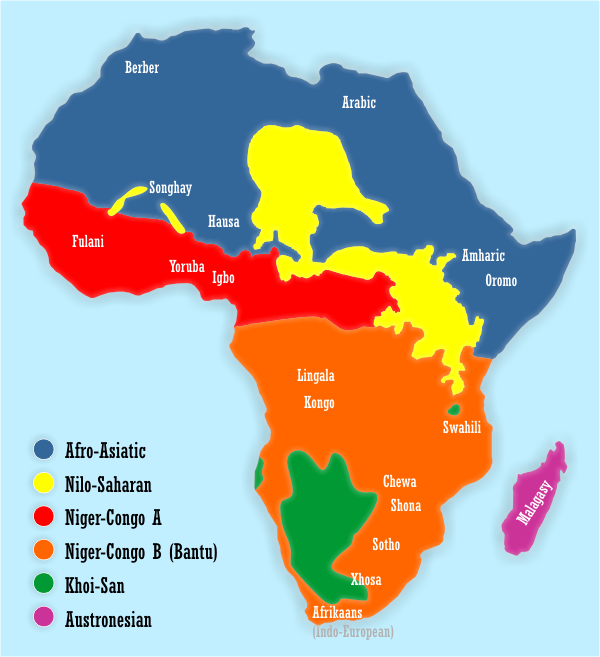
Ninth to 18th centuries
Pre-colonial Africa possessed perhaps as many as 10,000 different states and polities characterized by many different sorts of political organization and rule. These included small family groups of hunter-gatherers such as the San people of southern Africa; larger, more structured groups such as the family clan groupings of the Bantu-speaking peoples of central, southern, and eastern Africa; heavily structured clan groups in the Horn of Africa; the large Sahelian kingdoms; and autonomous city-states and kingdoms such as those of the Akan; Edo, Yoruba, and Igbo people in West Africa; and the Swahili coastal trading towns of Southeast Africa.
By the ninth century AD, a string of dynastic states, including the earliest Hausa states, stretched across the sub-Saharan savannah from the western regions to central Sudan. The most powerful of these states were Ghana, Gao and the Kanem-Bornu Empire. Ghana declined in the 11th century, but was succeeded by the Mali Empire which consolidated much of western Sudan in the 13th century. Kanem accepted Islam in the 11th century.

In the forested regions of the West African coast, independent kingdoms grew with little influence from the Muslim north. The Kingdom of Nri was established around the ninth century and was one of the first. It is also one of the oldest kingdoms in present-day Nigeria and was ruled by the Eze Nri. The Nri kingdom is famous for its elaborate bronzes, found at the town of Igbo-Ukwu. The bronzes have been dated from as far back as the ninth century. They displayed a level of technical accomplishment that was notably more advanced than European bronze casting of the same period.
The Kingdom of Ife, historically the first of these Yoruba city-states or kingdoms, established government under a priestly oba — “king” or “ruler” in the Yoruba language — called the Ooni of Ife. Ife was noted as a major religious and cultural center in West Africa, and for its unique naturalistic tradition of bronze sculpture. The Ife model of government was adapted at the Oyo Empire, where its obas or kings called the Alaafins of Oyo — once controlled a large number of other Yoruba and non-Yoruba city-states and kingdoms; the Fon Kingdom of Dahomey was one of the non-Yoruba domains under Oyo control.
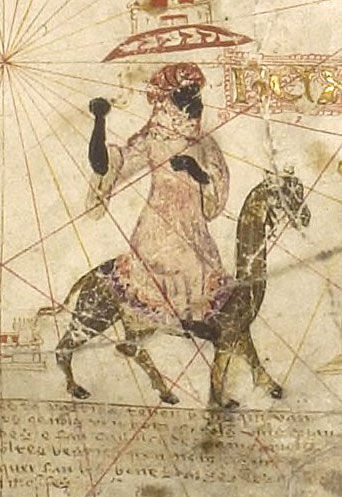
The Almoravids were a Berber dynasty from the Sahara that spread over a wide area of northwestern Africa and the Iberian peninsula during the 11th century. The Banu Hilal and Banu Ma'qil were a collection of Arab Bedouin tribes from the Arabian Peninsula who migrated westwards via Egypt between the 11th and 13th centuries. Their migration resulted in the fusion of the Arabs and Berbers where the locals were Arabized, and Arab culture absorbed elements of the local culture under the unifying framework of Islam.
Following the breakup of Mali, a local leader named Sonni Ali (1464–1492) founded the Songhai Empire in the region of middle Niger and the western Sudan and took control of the trans-Saharan trade. Sonni Ali seized Timbuktu in 1468 and Jenne in 1473, building his regime on trade revenues and the cooperation of Muslim merchants. His successor Askia Mohammad I (1493–1528) made Islam the official religion, built mosques and brought in Gao Muslim scholars, including al-Maghili (d.1504), the founder of an important tradition of Sudanic African Muslim scholarship. By the 11th century, some Hausa states — such as Kano, jigawa, Katsina and Gobir — had developed into walled towns engaging in trade, servicing caravans and the manufacture of goods. Until the 15th century, these small states were on the periphery of the major Sudanic empires of the era, paying tribute to Songhai to the west and Kanem-Borno to the east.
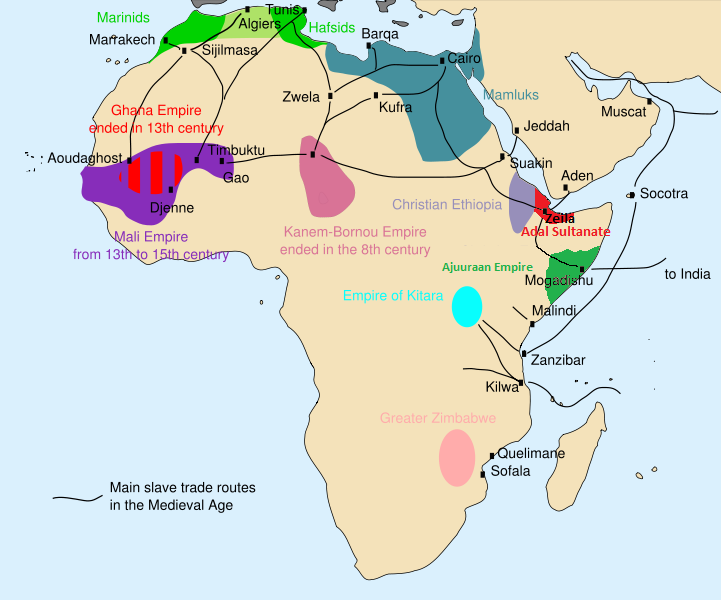
Height of the slave trade
Slavery had long been practiced in Africa. Between the 15th and the 19th centuries, the Atlantic slave trade took an estimated 7–12 million slaves to the New World. In addition, more than 1 million Europeans were captured by Barbary pirates and sold as slaves in North Africa between the 16th and 19th centuries.
In West Africa, the decline of the Atlantic slave trade in the 1820s caused dramatic economic shifts in local polities. The gradual decline of slave-trading, prompted by a lack of demand for slaves in the New World, increasing anti-slavery legislation in Europe and America and the British Royal Navy's increasing presence off the West African coast obliged African states to adopt new economies. Between 1808 and 1860, the British West Africa Squadron seized approximately 1,600 slave ships and freed 150,000 Africans who were aboard.
Action was also taken against African leaders who refused to agree to British treaties to outlaw the trade, for example against "the usurping King of Lagos," deposed in 1851. Anti-slavery treaties were signed with over 50 African rulers. The largest powers of West Africa — the Asante Confederacy, the Kingdom of Dahomey and the Oyo Empire — adopted different ways of adapting to the shift. Asante and Dahomey concentrated on the development of "legitimate commerce" in the form of palm oil, cocoa, timber and gold, forming the bedrock of West Africa's modern export trade. The Oyo Empire, unable to adapt, collapsed into civil wars.

Colonialism
The Scramble for Africa — also called the Partition of Africa or the Conquest of Africa — was the invasion, occupation, division and colonization of most of Africa by seven Western European powers during a short period known to historians as the New Imperialism between 1881 and 1914. The 10% of Africa that was under formal European control in 1870 increased to almost 90% by 1914, with only Ethiopia or Abyssinia and Liberia remaining independent, though Ethiopia would later be invaded and colonized by Italy in 1936.
The Berlin Conference of 1884 — which regulated European colonization and trade in Africa — is usually referred to as the starting point of the Scramble for Africa. There were considerable political rivalries among the European empires in the last quarter of the 19th century. Partitioning Africa was effected without wars between European nations. In the later years of the 19th century, the European nations transitioned from "informal imperialism" — i.e., exercising military influence and economic dominance — to direct rule, bringing about colonial imperialism.

Independence struggles
Imperial rule by Europeans would continue until after the conclusion of World War II, when almost all remaining colonial territories gradually obtained formal independence. Independence movements in Africa gained momentum following World War II, which left the major European powers weakened. In 1951, Libya, a former Italian colony, gained independence. In 1956, Tunisia and Morocco won their independence from France. Ghana followed suit the next year in March 1957, becoming the first of the sub-Saharan colonies to be granted independence. Most of the rest of the continent became independent over the next decade.
Portugal's overseas presence in Sub-Saharan Africa — most notably in Angola, Cape Verde, Mozambique, Guinea-Bissau and São Tomé and Príncipe — lasted from the 16th century to 1975, after the Estado Novo regime was overthrown in a military coup in Lisbon. Rhodesia unilaterally declared independence from the United Kingdom in 1965, under the white minority government of Ian Smith, but was not internationally recognized as an independent state as Zimbabwe until 1980, when black nationalists gained power after a bitter guerrilla war. Although South Africa was one of the first African countries to gain independence, the state remained under the control of the country's white minority through a system of racial segregation known as apartheid until 1994.
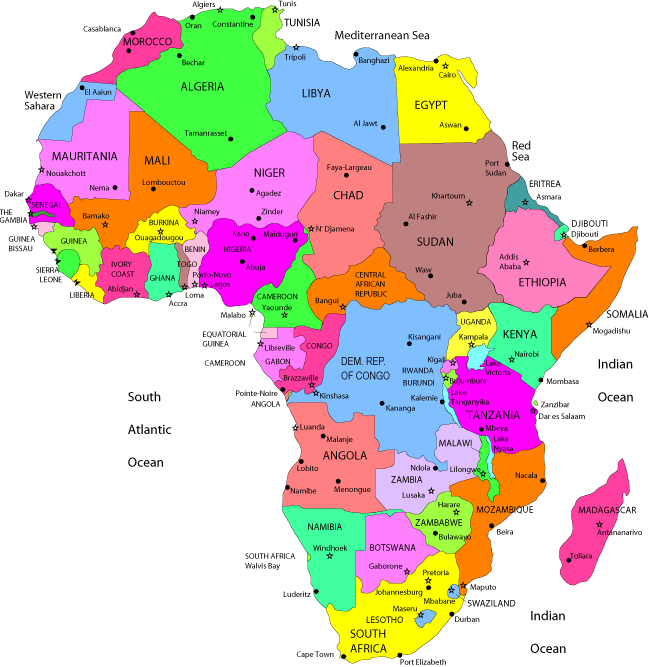
Post-colonial Africa
Today, Africa contains 54 sovereign countries, most of which have borders that were drawn during the era of European colonialism. Since colonialism, African states have frequently been hampered by instability, corruption, violence, and authoritarianism. The vast majority of African states are republics that operate under some form of the presidential system of rule. However, few of them have been able to sustain democratic governments on a permanent basis, and many have instead cycled through a series of coups, producing military dictatorships.
Great instability was mainly the result of marginalization of ethnic groups, and graft under these leaders. For political gain, many leaders fanned ethnic conflicts, some of which had been exacerbated — or even created — by colonial rule. In many countries, the military was perceived as being the only group that could effectively maintain order, and it ruled many nations in Africa during the 1970s and early 1980s. During the period from the early 1960s to the late 1980s, Africa had more than 70 coups and 13 presidential assassinations. Border and territorial disputes were also common, with the European-imposed borders of many nations being widely contested through armed conflicts.
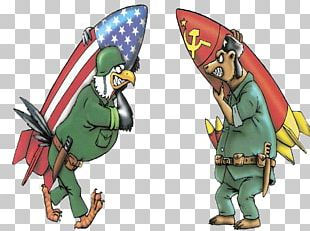
Cold War conflicts between the United States and the Soviet Union — as well as the policies of the International Monetary Fund — also played a role in instability. When a country became independent for the first time, it was often expected to align with one of the two superpowers. Many countries in Northern Africa received Soviet military aid, while others in Central and Southern Africa were supported by the United States, France or both. The 1970s saw an escalation of Cold War intrigues, as newly independent Angola and Mozambique aligned themselves with the Soviet Union, and West and South Africa sought to contain Soviet influence by supporting friendly regimes or insurgency movements. In Rhodesia, Soviet and Chinese-backed leftist guerrillas of the Zimbabwe Patriotic Front waged a brutal guerrilla war against the country's white government. There was a major famine in Ethiopia, when hundreds of thousands of people starved. Some claimed that Marxist economic policies made the situation worse. The most devastating military conflict in modern independent Africa has been the Second Congo War; this conflict and its aftermath has killed an estimated 5.5 million people. Since 2003 there has been an ongoing conflict in Darfur which has become a humanitarian disaster. Another notable tragic event is the 1994 Rwandan genocide in which an estimated 800,000 people were murdered.
In the 21st century, however, the number of armed conflicts in Africa has steadily declined. For instance, the civil war in Angola came to an end in 2002 after nearly 30 years. This coincided with many countries abandoning communist-style command economies and opening up for market reforms. The improved stability and economic reforms have led to a great increase in foreign investment into many African nations — mainly from China — which has spurred quick economic growth in many countries, seemingly ending decades of stagnation and decline. Several African economies are among the world's fastest growing as of 2016. A significant part of this growth — which is sometimes referred to as Africa Rising — can also be attributed to the facilitated diffusion of information technologies and specifically the mobile telephone. Migration from African nations has increased dramatically in the last decade.
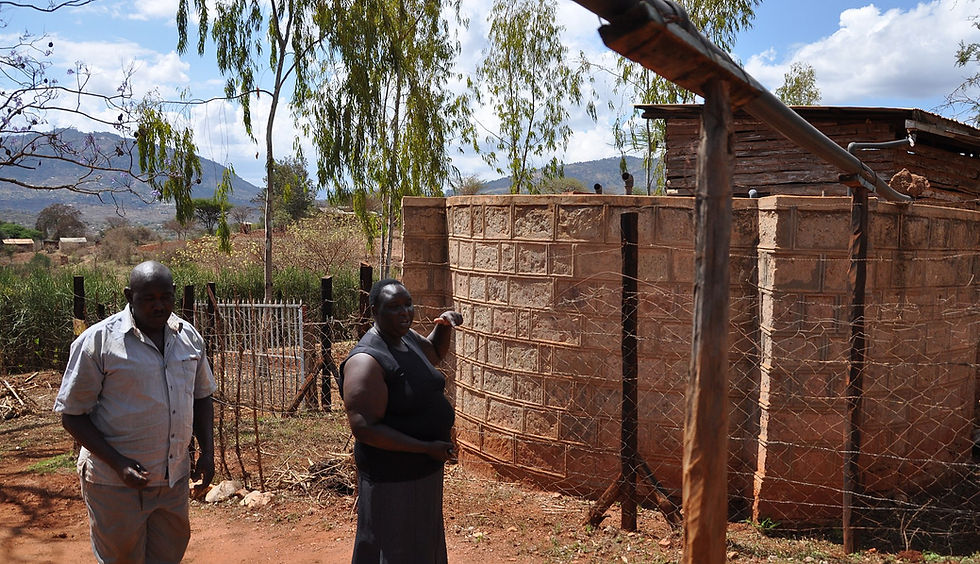
Climate change
Climate change in Africa is an increasingly serious threat for Africans, as Africa is among the most vulnerable continents to climate change. Anthropogenic climate change is already a reality in Africa, as it is elsewhere in the world. According to the Intergovernmental Panel on Climate Change, the vulnerability of Africa to climate change is driven by a range of factors that include weak adaptive capacity, high dependence on ecosystem goods for livelihoods and less developed agricultural production systems. The risks of climate change on agricultural production, food security, water resources and ecosystem services will likely have increasingly severe consequences on lives and sustainable development prospects in Africa. Managing this risk requires an integration of mitigation and adaptation strategies in the management of ecosystem goods and services, and the agriculture production systems in Africa.
Over the coming decades, warming from climate change is expected across almost all the Earth's surface, and global mean rainfall will increase. Regional effects on rainfall in the tropics are expected to be much more spatially variable and the sign of change at any one location is often less certain, although changes are expected. Observed surface temperatures have generally increased over Africa since the late 19th century to the early 21st century by about 1 °C, but locally as much as 3 °C for minimum temperature in the Sahel at the end of the dry season. Observed precipitation trends indicate spatial and temporal discrepancies as expected. The observed changes in temperature and precipitation vary regionally.
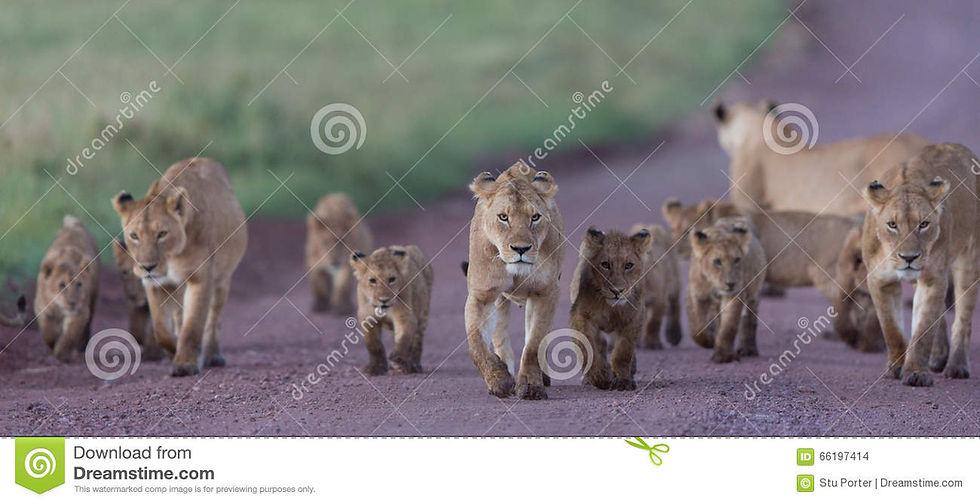
Fauna
Africa boasts perhaps the world's largest combination of density and "range of freedom" of wild animal populations and diversity, with wild populations of large carnivores such as lions, hyenas and cheetahs and herbivores such as buffalo, elephants, camels and giraffes ranging freely on primarily open non-private plains. It is also home to a variety of "jungle" animals including snakes and primates, along with aquatic life such as crocodiles and amphibians. In addition, Africa has the largest number of megafauna species or giant animals, as it was least affected by the extinction of the Pleistocene megafauna.
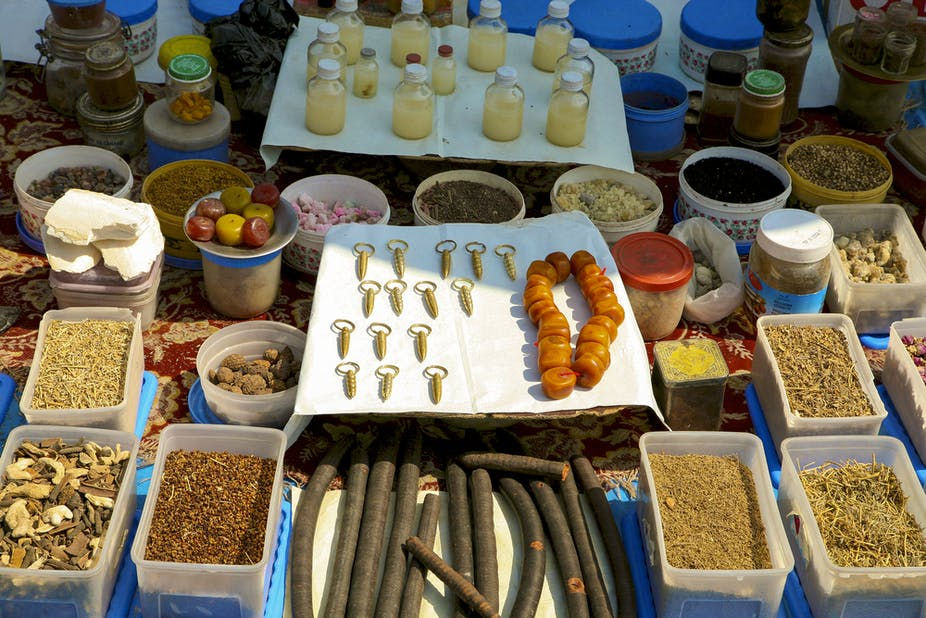
Health
More than 85% of individuals in Africa use traditional medicine — a range of traditional medicine disciplines involving indigenous herbalism and African spirituality, typically including diviners, midwives and herbalists — as an alternative to often expensive allopathic medical health care and costly pharmaceutical products. The Organization of African Unity or OAU heads of state and government declared the 2000s decade as the African Decade on African traditional medicine in an effort to promote the WHO African Region's adopted resolution for institutionalizing traditional medicine in health care systems across the continent. Public policy makers in the region are challenged with consideration of the importance of traditional/indigenous health systems and whether their coexistence with the modern medical and health sub-sector would improve the equitability and accessibility of health care distribution, the health status of populations and the social-economic development of nations within sub-Saharan Africa.
AIDS in post-colonial Africa is a prevalent issue. Although the continent is home to about 15.2% of the world's population, more than two-thirds of the total infected worldwide — some 35 million people — were Africans, of whom 15 million have already died. Sub-Saharan Africa alone accounted for an estimated 69% of all people living with HIV and 70% of all AIDS deaths in 2011. In the countries of sub-Saharan Africa most affected, AIDS has raised death rates and lowered life expectancy among adults between the ages of 20 and 49 by about 20 years. Furthermore, the life expectancy in many parts of Africa is declining, largely as a result of the HIV/AIDS epidemic with life expectancy in some countries reaching as low as 34 years.

Religion
While Africans profess a wide variety of religious beliefs, the majority of the people respect African religions or parts of them. However, in formal surveys or census, most people will identify with major religions that came from outside the continent, mainly through colonization. There are several reasons for this, the main one being the colonial idea that African religious beliefs and practices are not good enough. Religious beliefs and statistics on religious affiliation are difficult to come by since they are often a sensitive topic for governments with mixed religious populations. According to the World Book Encyclopedia, Islam and Christianity are the two largest religions in Africa. According to Encyclopædia Britannica, 45% of the population are Christians, 40% are Muslims and 10% follow traditional religions. A small number of Africans are Hindu, Buddhist, Confucianist, Baháʼí or Jewish. There is also a minority of people in Africa who are irreligious.
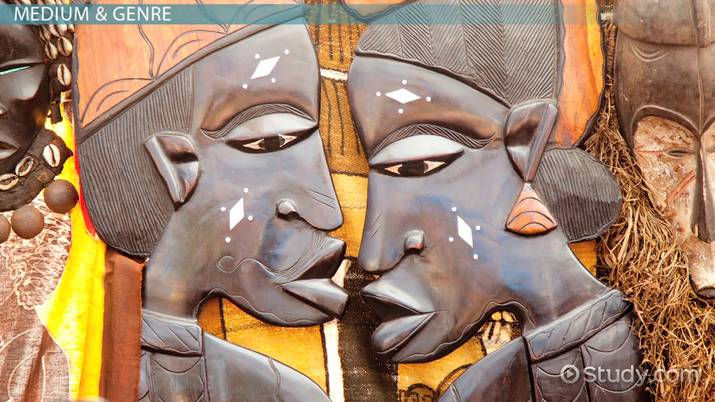
Culture
Some aspects of traditional African cultures have become less practiced in recent years, as a result of neglect and suppression by colonial and post-colonial regimes. For example, African customs were discouraged and African languages prohibited in mission schools. Leopold II of Belgium attempted to "civilize" Africans by discouraging polygamy and witchcraft.
Obidoh Freeborn posits that colonialism is one element that has created the character of modern African art. According to authors Douglas Fraser and Herbert M. Cole, "The precipitous alterations in the power structure wrought by colonialism were quickly followed by drastic iconographic changes in the art." Fraser and Cole assert that, in Igboland, some art objects "lack the vigor and careful craftsmanship of the earlier art objects that served traditional functions.” Author Chika Okeke-Agulu states that "the racist infrastructure of British imperial enterprise forced upon the political and cultural guardians of empire a denial and suppression of an emergent sovereign Africa and modernist art." Editors F. Abiola Irele and Simon Gikandi comment that the current identity of African literature had its genesis in the "traumatic encounter between Africa and Europe." On the other hand, Mhoze Chikowero believes that Africans deployed music, dance, spirituality and other performative cultures to (re)asset themselves as active agents and indigenous intellectuals — to unmake their colonial marginalization and reshape their own destinies."
There is now a resurgence in the attempts to rediscover and revalue African traditional cultures, under such movements as the African Renaissance, led by Thabo Mbeki; Afrocentrism, led by a group of scholars including Molefi Asante; and the increasing recognition of traditional spiritualism through decriminalization of Vodou and other forms of spirituality.
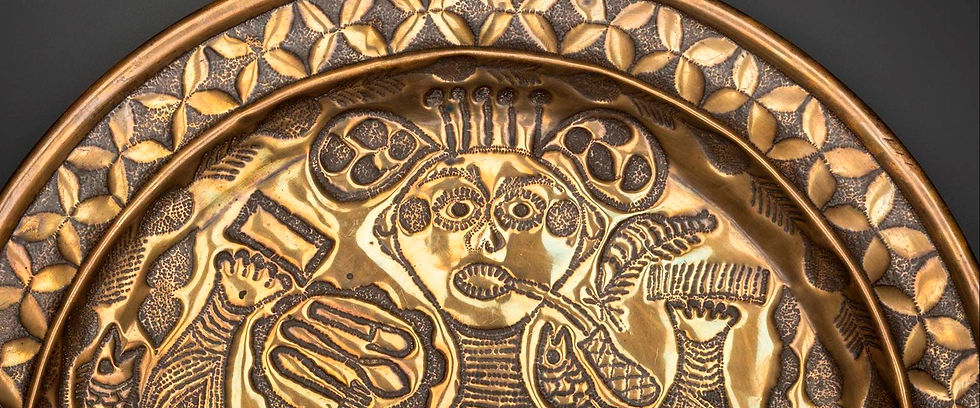
Visual art
African art describes the modern and historical paintings, sculptures, installations and other visual culture from native or indigenous Africans and the African continent. The definition may also include the art of the African diasporas, such as African American, Caribbean or art in South American societies inspired by African traditions. Despite this diversity, there are unifying artistic themes present, when considering the totality of the visual culture from the continent of Africa.
Pottery, metalwork, sculpture, architecture, textile art and fiber art, are important visual art forms across Africa and may be included in the study of African art. The term "African art" does not usually include the art of the North African areas along the Mediterranean coast, as such areas had long been part of different traditions. For more than a millennium, the art of such areas had formed part of Berber or Islamic art, although with many particular local characteristics.
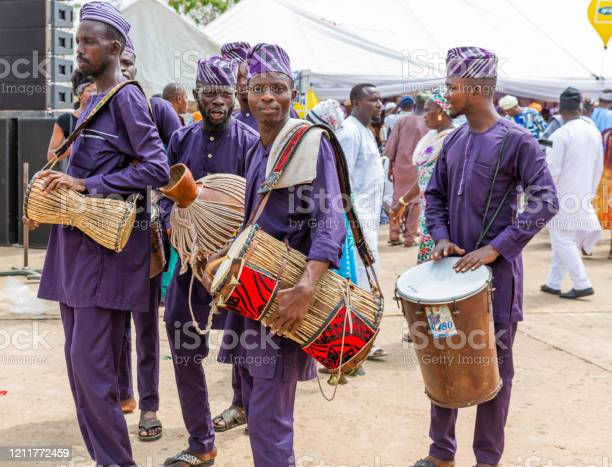
Music
Given the vastness of the African continent, its music is diverse, with regions and nations having many distinct musical traditions. African music includes the genres Jùjú, Fuji, Highlife, Makossa, Kizomba, Afrobeat and others. The music and dance of the African diaspora, formed to varying degrees on African musical traditions, include American music like Dixieland, the blues, jazz, old-time and bluegrass, along with many Caribbean genres such as calypso and soca. Latin American music genres such as zouk, bomba, conga, rumba, son, salsa, cumbia and samba, were founded on the music of enslaved Africans, and have in turn influenced African popular music.
Like the music of Asia, India and the Middle East, it is a highly rhythmic music. The complex rhythmic patterns often involving one rhythm played against another to create a polyrhythm. The most common polyrhythm plays three beats on top of two, like a triplet played against straight notes. Sub-Saharan African music traditions frequently rely on percussion instruments of many varieties, including xylophones, djembes, drums and tone-producing instruments such as the mbira or "thumb piano."
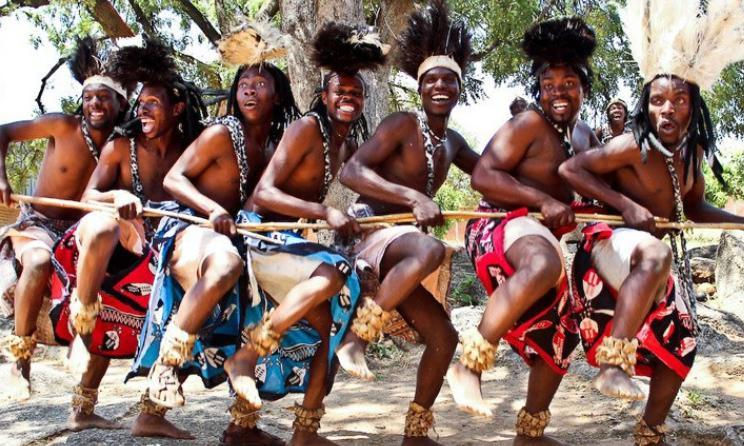
Dance
The term African dance refers mainly to the numerous dance styles of Sub-Saharan Africa. These dances must be viewed in close connection with the traditional rhythms and music traditions of the region. Music and dancing is an integral part of many traditional African societies. Songs and dances facilitate teaching and promoting social values, celebrating special events and major life milestones, performing oral history and other recitations and spiritual experiences. African dance utilizes the concepts of polyrhythm and total body articulation. African dances are a collective activity performed in large groups, with significant interaction between dancers and onlookers in the majority of styles.




Comments